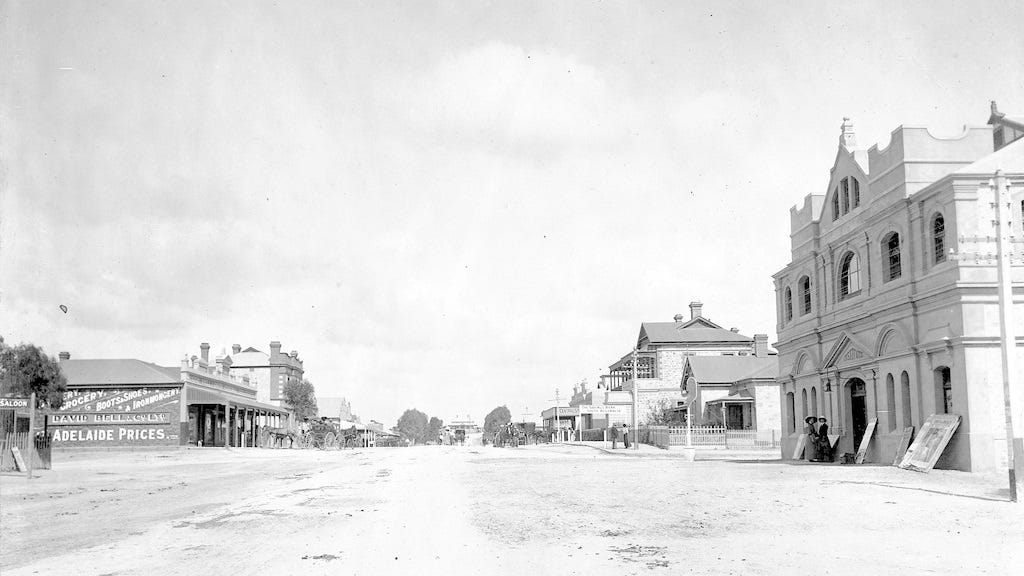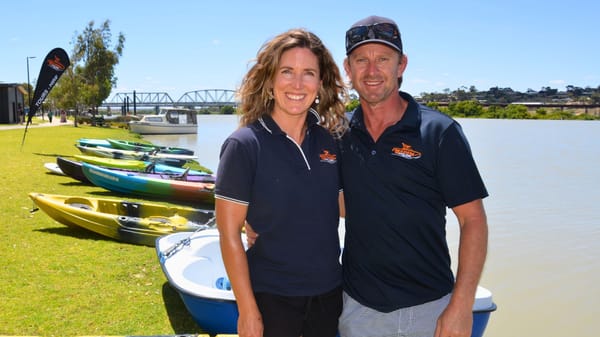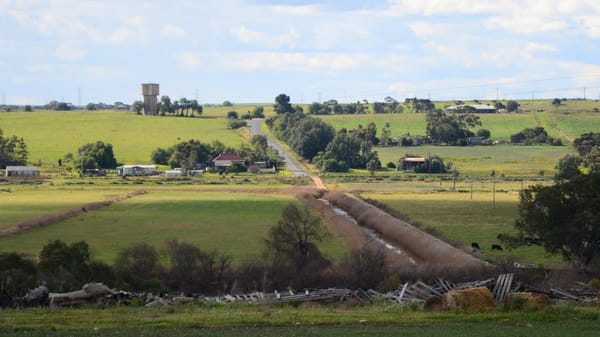Walk of the month: Murray Bridge Discovery Trail
Graham Hallandal invites you to explore local history as you walk through the heart of the river city.

Summer need not be the end of taking a regular walk.
Make an early start before the day warms up, or later on days when we are fortunate enough to get a cooler southerly breeze from the lakes.
If your walking ability is limited, most of the points of interest are accessible by car and a short walk.
This month our featured walk is located around the Murray Bridge CBD.
It takes in the area’s rich Indigenous culture, our heritage and history, gardens and views of the river.
Along the way, learn about the area’s Ngarrindjeri and European history, including the stories of Captain Charles Sturt, the Edwards family and the construction of the first bridge across the Murray River; river trade through Port Mobilong; the 1956 flood; and the Murray Cods, the rowers who represented Australia at the 1924 Olympic Games.
Allow an hour and a half for a leisurely stroll or the walk can be broken up into smaller segments.
First, some background.
Today Murray Bridge is one of South Australia’s largest towns.
The Chronicle newspaper reported in 1933 that:
The population in 1873 (was) three families; in 1933, 5000. There, in a nutshell, you have the progress of Murray Bridge in 60 years. But it wasn’t Murray Bridge in 1873, because there wasn’t any bridge. It was just called Edwards’ Crossing. And a wild, desolate region it was. The eastern side of the river was almost impassable swamp. The western side was dense scrub. There were no cleared reads, not even when they built the bridge. They just dumped a costly structure in the middle of the bush and left it there. It was the first bridge across the Murray in South Australia. People got into the habit of calling it Murray Bridge. Then a few families came and settled about the banks of the river. Soon they formed a tiny village without a name, except the one generally bestowed by the travelling public. Murray Bridge is still without an officially bestowed identification disc. It was never christened. It just grew, and the old designation stuck. Now, I suppose, you couldn’t shift it if you tried— not even if you wanted to substitute the native name of Mobilong.

Our start point, marked 1 on the map, is at the Ngarrindjeri mosaic and mural at the local government centre.
The mosaic tells the story of Ngurunderi, the great ancestral creator.
You can also view the mural in the foyer of the local government centre on days when it is open.
Be aware that the adjacent car park is for visitors to the local government centre so, if undertaking this walk, it would be advisable to park in another location to avoid receiving a parking ticket.
From the mural, walk along the path towards Seventh Street, cross South Terrace up the hill to Bridge Street to location 2 on the map, where there is a historical plaque of Bridge Street.

Once the main retail hub of town, there were housed blacksmiths, saddlers, a brewing company, butchers, bakers and general stores.
By the mid-1900s it had a theatre, underground dance hall, pool parlour and many old buildings, most with veranda posts.
Just ahead of you, across Bridge Street, there was once an ice cream factory.
Turn right and walk one block to Sixth Street.
Once located in this block were stores such as Subway Music, in a basement where Ray White now stands after the original building burnt down; Eudunda Farmers, now MADEC and AC Care; and Bell’s Department Store, now Sportspower.
The main road between Adelaide and Melbourne used Bridge Street, so crossing from one side to the other with all the traffic was sometimes difficult.
In May 1979 the Swanport Bridge and bypass opened, shifting through traffic out of the town.
At location 3, the town hall is on the northeast corner of Sixth Street.

Built in 1911, it received a major upgrade costing $4.2 million in 2010 that also added the regional gallery at the rear of the hall.
Exhibitions change regularly, so a visit is a worthwhile diversion.
Across the road from the gallery is the Murray Bridge Hotel, still retaining its veranda and posts.
Built in 1914, it has a state heritage listing.
Sixth Street received a $3.4 million streetscape upgrade completed in 2017 with one-way traffic away from Bridge Street.
The next building on the left is the Parklane Motel and Vietnamese restaurant, originally the post office from 1911 to 2013.
Location 4 is the historic railway station building.

Built in 1886, the refreshment rooms were once used by hundreds of travellers every day.
In the heyday of the daily Overland, it was the stop-off for supper with a rush for a pie or cup of tea.
It fell into disrepair until it was taken over by council, beautifully restored and now serves as a youth centre.
Across the road is one of the last remaining retail buildings built in 1881.
Travel right along Railway Terrace towards Bridge Street.
Ahead is the new Bridgeport Hotel under construction.
The $45 million project of 100 rooms is to be completed by 2022.
The original building goes back to 1884.

Turn sharp left and cross the narrow bridge to the railway precinct, map location 5.
The cutting crossed by this bridge was once the location of the rail line when all trains shared the road bridge.
In May 1886, the first train crossed the bridge; in 1925, the last train crossed.
The road divides in two.
Turn left and you can walk to railway buildings beautifully restored by the historical society.
Time your walk to arrive between 10am and 2pm on a Tuesday and you can inspect the interiors of the buildings.
Murray Bridge became the main locomotive depot and administration centre between Adelaide and the Victorian border, with a large engine shed and turntable.
The turntable, built in 1883 in Delaware, USA and installed in 1884, is still in place opposite the grain silos.
The area is state heritage listed.
The road to the right leads to location 6, the Round House.

Built in 1874 in an unusual hexagon shape, the 147-year-old former residence belonged to the man in charge of building the road bridge.
Later it served as a school, post office, church and council chambers.
The building has recently been updated and revitalised.
Take the path on the right side of the building, enjoy the views overlooking the river and continue through the gardens down the zig-zag path to the river level.
Turn right.
The wharf upstream from the road bridge is used by the 120-passenger Murray Princess, the largest inland paddle-wheeler in the Southern Hemisphere.
Because of its size, it docks in this location as it cannot fit under the road bridge.
Next, go under the bridges – 7 on the map.

In 1865 Parliament voted to pay £20,000 for the road bridge.
In 1866 it was ordered; in 1867-68 it arrived in sections and the government found itself with a bridge on its hands that it didn’t know what to do with.
It was taken to Dry Creek, dumped alongside the railway line, and left there rusting while debate over the site to build it continued for many more years.
On November 7, 1873 they finally laid the foundation stone and completed construction in 1879.
Located between the bridges is the Pump House.
Built in 1879, it supplied water to the town until 1960.
Construction of the railway bridge commenced in 1924 and finished 12 months later.
It is the largest rail bridge still in use in the state and is able to take all heavy locomotives.
The third, or eastern, span is the longest and passes over the navigation channel on the other side of the river.
The wharf precinct is number 8.

Rail lines can still be seen as you walk under the bridges.
They were laid to the wharf in 1886 but are now isolated from the main lines, which were converted from broad to standard gauge in 1995.
Originally of two levels, the wharf was 190 metres long with a further 145 metres of sheet piling at deck level, and was serviced by two rail lines.
The crane on the wharf has a National Trust plaque and was one of six used to transfer freight from ship to rail.
It was not uncommon to see up to 20 streamers and barges at the wharf at one time in the 1920s and 1930s.
During 1910, more than 35,000 tons of freight was trans-shipped across the wharf between the railway and boats.
On occasions freight transfer resulted in 16 trains leaving Murray Bridge in the one day.
The Captain Proud paddle boat is based at the wharf. It takes daily lunch and evening trips that can be booked at the information centre.
You may also see the Proud Mary berthed.
This ship takes 36 passengers on two- and five-night cruises.
Head away from the river along the path leading to Wharf Hill.
The Union milk boat of the 1920s is to your right, with other historic items awaiting restoration.
It was brought to this location from the South East, where it had been used as a crayfish boat.
Deviate to the left to the new RSL memorial, Wharf Hill’s landscaped gardens, water features and a gazebo overlooking the river.
Return to the start point by crossing East Terrace and head either down Bridge Street or South Terrace.
A Murray Bridge Discovery Walk brochure is available from the Murray Bridge Information Centre on South Terrace.
You can help keep local stories like this one free for everyone to read. Subscribe to Murray Bridge News today and support your locally owned news outlet, plus get access to exclusive stories you won’t find anywhere else, for just $5.50 a month.




